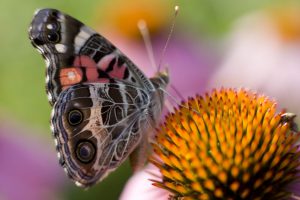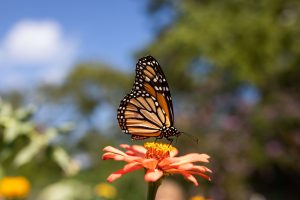This week is National Pollinator Week, which makes it a good time to learn about how birds, bees, hummingbirds, and other pollinators sustain our ecosystem!
What is a pollinator?

When some people hear “pollinator,” they immediately think of bees. That’s not wrong—bees are pollinators! But the term “pollinator” refers to any animal that brings pollen from male parts of flowers to female parts, allowing plants to reproduce. Some other pollinators are hummingbirds, butterflies, and even wasps.
Pollinators and plants live in symbiosis. They are adapted to benefit each other. Plant reproduction by pollination allows for new plants that differ from their parents, diversifying the gene pool. Meanwhile, the plants provide food and sometimes host sites for pollinator larvae.
Good for the plants, but where do I come in?
In the recent AskIFAS article Concepts for Sustainable Landscape Mosaics, Tina McIntyre, Rachel Gutner, and Sandra Wilson point out that
Pollinators are essential to human existence; their efforts contribute to a third of all food that humans eat. Even if pollinators are not directly pollinating human food crops, those plants often feed other organisms that we depend on. Pollinators also contribute greatly to healthy ecosystems because they transport pollen to plants that stabilize our soil, clean our air, supply oxygen, and support wildlife.

The authors also offer ideas for a Florida-friendly pollinator-concept mosaic. In their words, a mosaic is “a landscape composed of plants that bloom at specific times, have seasonality (including dieback), and exhibit different textures, shapes, and sizes.” Not only can you feel good about your landscape’s role in the environment, but you can also plant to attract the pollinators you want to see.
See also A Guide to Planting Wildflower Enhancements in Florida and the Florida-Friendly Landscaping™ Bee Garden and Butterfly Garden pages for help designing your landscapes.
Be careful with pesticides!
Pollinators aren’t just important to the ecosystem in general. Agriculture in the US, and specifically in Florida, uses both wild and “for-hire,” managed bees to assist in pollination. And that means those bees are likely to encounter pesticides as they go about their business. The Environmental Protection Agency has a policy including recommended labeling statements designed to mitigate the risk to bees; for details, see Pesticide Labeling: Protection of Pollinators.
For a more comprehensive guide to the effects of pesticides on honey bees, including approaches to reduce risks to bees, consult Minimizing Honey Bee Exposure to Pesticides.
To learn more about bees and other pollinators, refer to the AskIFAS topic pages Bees for Pollination and Hummingbird Gardening, click the “Pollinators” tag on this post, or get in touch with your local UF/IFAS Extension agent. And finally, for more on National Pollinator Week, visit the Pollinator Partnership for activities and events in your area!
 0
0
